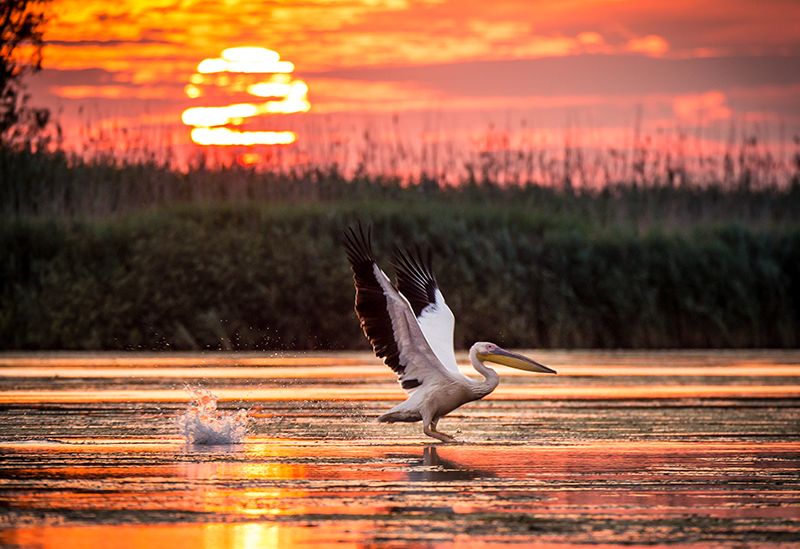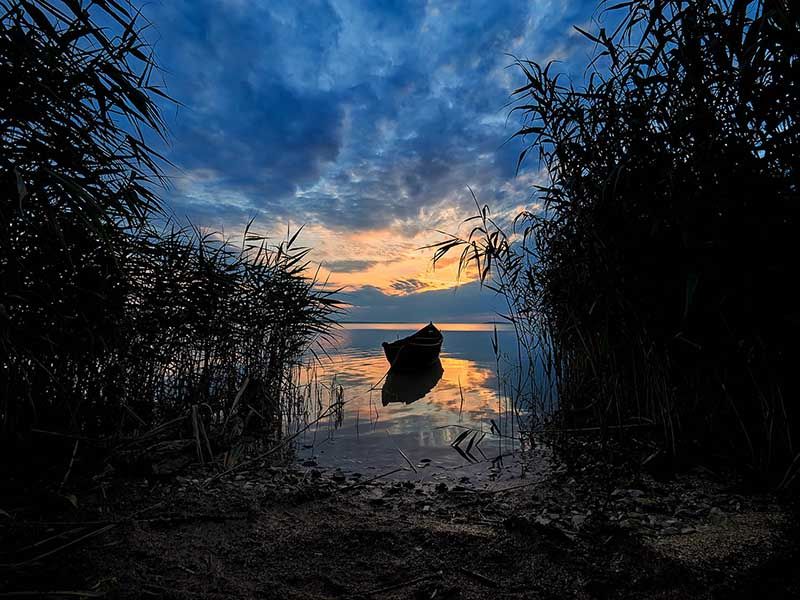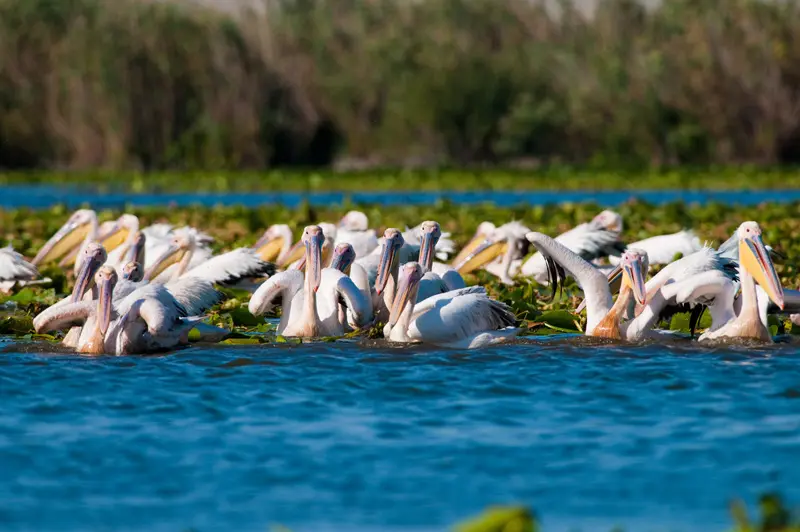Chapters
Where is the Danube Delta?
The biggest part of the Danube Delta is in Romania, and a smaller part is in Ukraine- Odesa region.
The Danube Delta in Romania is the best-preserved river delta in Europe and the largest after the Volga Delta. Over 80% of its surface area is spread over Romania in Tulcea County. The rest is located in Ukraine.
The Romanian part of the Danube Delta was included as a UNESCO World Heritage Site in 1991, and approximately 80% of its surface is strictly protected.
The immediate access to the Danube Delta is from Tulcea harbour. In the last years, the south part of the Danube delta has become famous for tourism, and the new route access is Murghiol. Most of the tourists choose the fisherman villages for accommodation like Mila 23, Crisan, or Dunavatu de Jos, and in a small portion, the floating hotels. From here, the boat tour can enter on the small channel in the heart of the Delta, inaccessible to the large boats.
Visit the Danube Delta, this unique ecosystem that has become a refuge for numerous species of birds, fish, and amphibians. In the paradise of the delta, the splash of oars pushed by fishermen with long beards and sun-withered faces is one of the few human-made sounds disrupting the silence of this untamed place, of this green island populated by thousands of wildlife species.

Formation & history
How was the Danube Delta formed?
The River Danube is Europe’s second-longest river, and it springs from the Black Forest in Germany. It flows through 10 countries (Germany, Austria, Slovakia, Hungary, Croatia, Serbia, Bulgaria, Romania, Moldova, and Ukraine), and it spills into the Black Sea, mostly in the territory of Romania.
The Danube Delta began forming roughly 6,000 years ago, in 4,000 BCE, in one of the bays of the Black Sea, when a barrier of sand generated by the rising level of the sea blocked the bay of the Danube River.
Over time, the bay filled with sediment, and the Delta started advancing towards the Black Sea, building numerous successive branches (the St. George I Branch, the Sulina Branch, the Saint George II Branch, and the Chilia/Kilia Branch).
The Danube River brings more than 67 million tons of alluvial every year, which contributes to the extension of the Delta and, at the same time, a barometer of the fragile balance of the environment. It has been proved that deforestation involves a larger quantity of alluvial and, as a consequence, the risk of suffocating aquatic plants.
Recorded history states that the Dacians inhabited the Danube Delta region until the Romans conquered the area, and the Goths later invaded it. The Danube Delta became part of the Ottoman Empire in the 15th century, and in 1812, the borders of the Ottoman and Russian Empires were set by the Branches of the Delta. After the defeat of the Ottoman Empire in 1878, the Delta was split between Romania and Russia, and it was included in UNESCO’s Patrimony in 1991.
In 1998, UNESCO’s Programme on Man and the Biosphere included the whole Danube Delta as a biosphere reserve shared by both Romania and Ukraine.
The Danube River splits in 3. The channels of the Danube are Chilia Arm (Bratul Chilia), Sulina Arm (Bratul Sulina), and Sfantu Gheorghe Arm (Bratul Sfantu Gheorghe).
The Chilia Arm (Tulcea—Chilia Veche—Periprava), the youngest arm of the Delta, is the northern arm of the Danube Delta and has a length of 111 km. Because the Danube Delta grows annually by approximately 40 m², for a century and a half ago, the Chilia arm formed a secondary delta. The Chilia arm was, in the Middle Ages, the main route of navigation in the Delta, and for this reason, it was often disputed between the powers of the time.
Sulina Arm (Tulcea—Crisan—Sulina) is the shortest and straightest arm of the Danube Delta. The channel was dug between 1862 and 1902, reducing its length from 93 km to 64 km, doubling the volume of water. It requires permanent dredging works to be navigable for seagoing vessels. Sulina is also the most eastern place in Romania.
Sfantu Gheorghe Arm (Tulcea – Sfantu Gheorghe) is the oldest arm, carrying 22% of the volume of water. It is 112 kilometres long and carries 22% of the river’s flow. Sfantu Gheorghe Arm also suffered some transformation in its length, shortening to 70 km of navigable water.
The European Danube commission: The organization was established in 1856 after the end of the Crimean War and was a successful model of European cooperation through a set of internationally accepted rules and procedures.
The ‘European Commission of the Danube’ made up of riverine countries such as Romania, Bulgaria or Serbia, as well as the major shipping powers at that time, such as Great Britain, the Austrian Empire, and France – was set up to guarantee freedom of commerce and navigation along the Danube River for all European countries. Excepting the two world wars period when the European Danube Commission entered under the influence of the leading powers involved in the conflict, the institution functioned till 1948.
The main center of the commission was established at Galati and a secondary one in Sulina. The principle of the Danube Commission is considered a source of inspiration for what is today the European Union.
The Sulina Cemetery: Sulina port is the gateway to the Danube Delta, and once a cosmopolite city like a Babylon of nationalities, is today only a shadow of the lost charm.
Sulina branch is the main one that connects the Danube with the Black Sea coast, and people coming from Greece, Turkey, Northern Afrika, Rusia, and the Middle East were looking for rest in Sulina, after a long journey. The only thing that reminds of the old glory is the Sulina Cemetery, where are buried Christians, Muslims, Hebrew, and over 20 nations, from beggars to princess and even a pirate, the only one of this kind in Europe.
Ecosystems
The Danube Delta Romania is part of the Pannonian steppe ecosystem of Eastern Europe, but the Delta itself hosts 23 natural ecosystems. Due to the vast amounts of wetlands, the aquatic environment dominates much of its surface, with terrestrial environments being present only on a couple of higher grounds.
Being situated on one of the major migratory routes, the Danube Delta provides perfect nesting and hatching conditions. It is thus a magnet for birds from six significant ecoregions of the world, including the Mongolian, Arctic, and Siberian.

During summer, the Delta is home to over 320 species of birds, including the largest colony of pelicans, and over one million individual specimens winter here, including swans, wild ducks, and coots. This is also one of the last remaining places in Europe where wild horses roam free in the Letea Forest.
For nature lovers, the Danube Delta is the perfect place to enjoy the diversity and the serenity. If you are passionate about bird watching and exploring the Danube Delta, here are a few birds species that you can see: lesser white-fronted goose (Anser erythropus), lesser spotted eagle (Clanga pomarina), common sandpiper (Actitis hypoleucos), short-eared owl (Asio flammeus), dalmatian pelicans (pelicanus crispus), great white pelican (pelecanus onocrotalus), squacco heron, etc.
Besides the numerous species of birds and animals, the Danube Delta natural reserve is also inhabited by around 20,000 people. And almost 5,000 live in the port-town of Sulina. The rest of the inhabitants are scattered among 27 villages, of which only three are inhabited by more than 500 people. This accounts for an average density of 2 inhabitants per square km.
Amidst the expanse of reeds, the fishermen have built fishing villages, inhabited to this day by people who have learned to live with meager resources, surrounded by waters. For them, fish is a staple diet, but it is prepared in dozens of ways, capable of delighting the most sophisticated of connoisseurs.
Out of the ten countries crossed by the Danube, Romania is by far the most privileged one, as it hosts Europe’s last natural paradise: a delta formed at the meeting point of three tributaries, just before the river empties into the Black Sea. The entire area boasts an astonishing diversity in terms of wildlife and landscapes of unmatched beauty.
Thanks to our Delta, Romania’s tourist and scientific potential is enhanced. In fact, since 1991, the Danube Delta Biosphere Reserve has been listed as a world heritage site. It’s the third larger biodiversity area in the world after the Great Barrier of Corals in Australia and The Galapagos Islands in Ecuador. This makes the Danube Delta Biosphere reserve one of the best areas for bird-watching tours starting at the end of March till May, during the bird’s migration when it’s the perfect occasion to see the mating rituals.

What makes the Danube Delta one of a kind?
- The forests of Letea Village and Caraorman are the only areas in Europe where we still encounter tropical creepers. Moreover, the seeds of exotic plants brought by migratory birds from Africa and have added an exotic touch to the landscape. Now, the lush vegetation looks like a small-scale jungle.
- The richness of the Danube Delta area doesn’t strictly refer to its natural richness but also its historical heritage. Numerous archaeological sites existing today (Roman forts and ruins of Greek, Byzantine, or Getic fortresses) give this realm a legendary dimension.
- The Danube Delta is the largest and most compact reed area on Earth.
- One of the strangest plants from the Danube Delta is “Noctiluca miliaris.” An aquatic plant whose fluorescent color conveys the effect of magical water; this is why people call it the “sea-candle.”

Photo source: RomaniaTV.Net
The local culture
The hard conditions of living made the Danube Delta the region of Europe with the lowest density of population.
A distinctive population is the lippovans that come in this area from Russia 4 centuries ago. They are living in small communities in few villages and are still speaking a dialect of the Russian language, but the religion still keeps the elements of the original orthodox church.
Men can be recognized after the long beards, while women are famous for folk costumes and old songs. Even the houses in this area are distinct by the architecture where was kept: white walls with the carpentry painted in blue, while the roof is made from local materials, a thick layer of reeds
You can visit Danube Delta on a day tour from Tulcea or have full experience on a four days trip from Bucharest.
For Danube Delta Boat Transportation, you can check this website.



